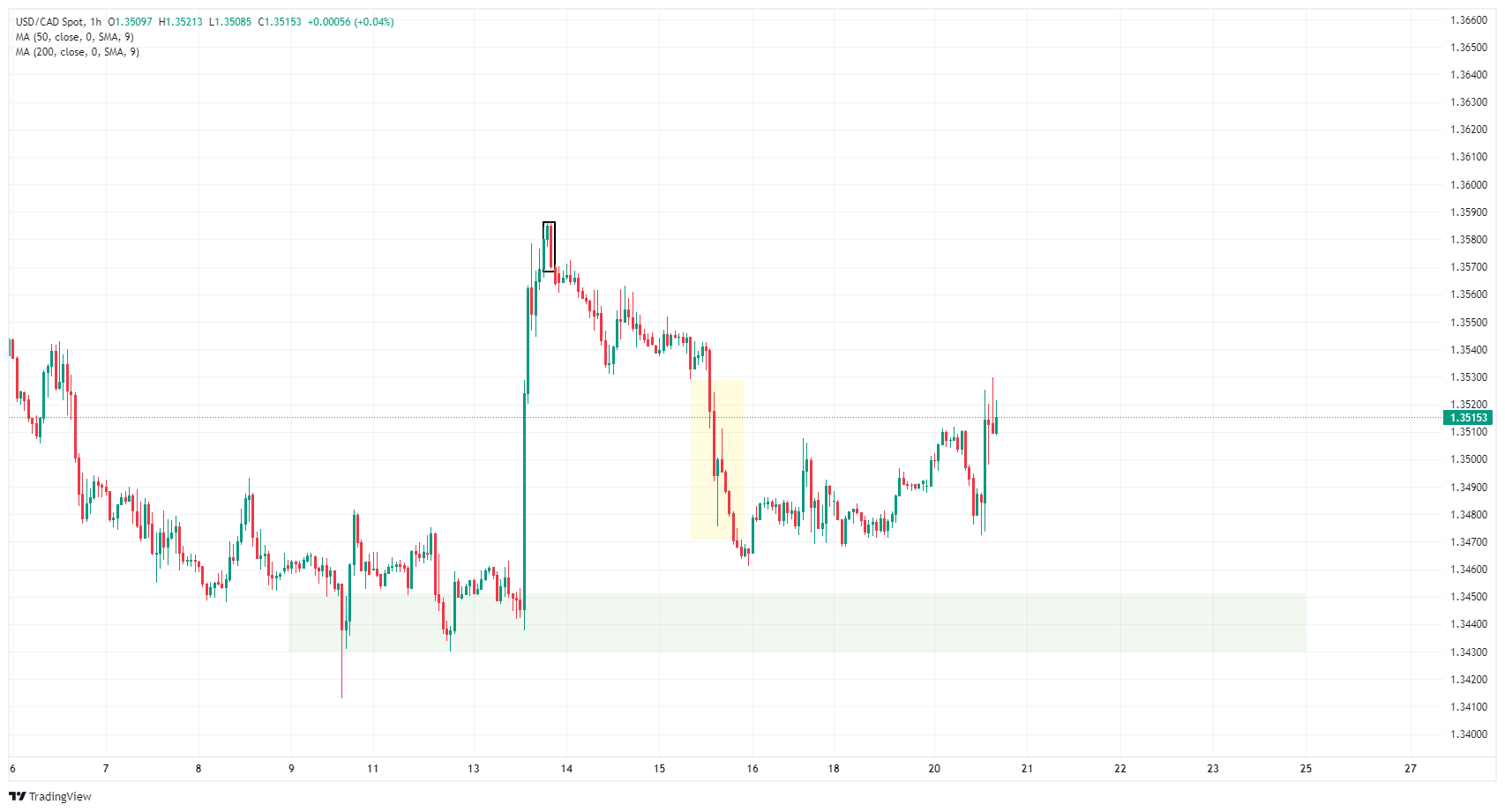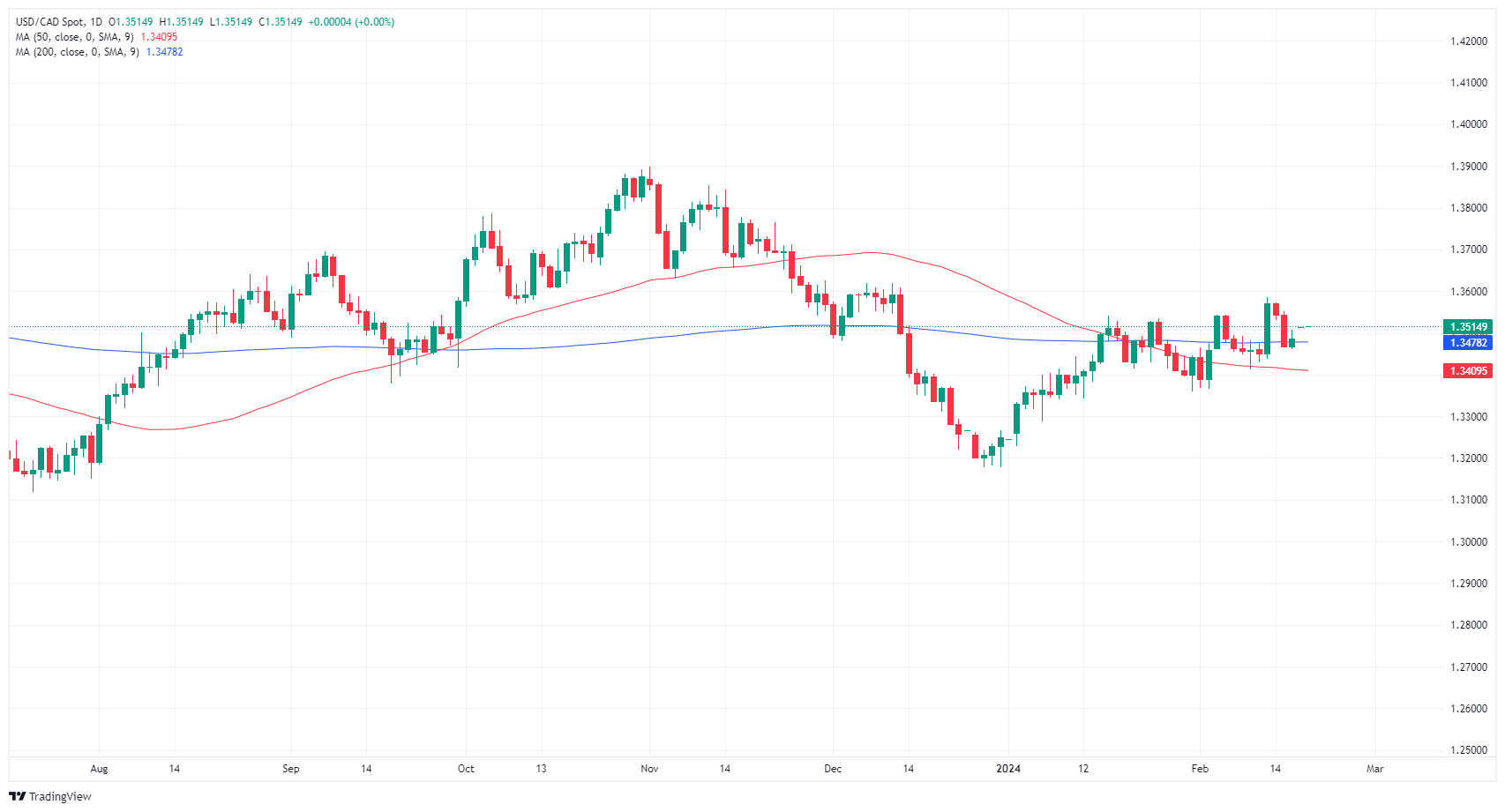- USD/CAD saw initial declines before being bolstered by weakness in the Canadian CPI.
- Canadian CPI inflation fell to 2.9% from 3.4% year-over-year previously.
- FOMC meeting minutes will be released on Wednesday as investors focus on rates.
USD/CAD fell to a daily low of 1.3472 on Tuesday before bouncing to an intraday high of 1.3530 after Canadian Consumer Price Index (CPI) inflation fell faster than markets expected. Weaker than expected Canadian inflation data weakened the Canadian Dollar (CAD) overall.
Canadian Retail Sales will be released on Thursday, with markets focusing on the Federal Reserve (Fed) and the Federal Open Market Committee (FOMC). The latest minutes of the FOMC meeting will be published on Wednesday.
Daily Market Summary: USD/CAD nears 1.3500 as Canadian inflation eases
- Canadian CPI inflation fell to 2.9% in January, well below expectations, to 3.3% from 3.4% in the previous period.
- The Canadian month-on-month CPI for January unexpectedly stood at 0.0%, compared to the expected rebound from -0.3% the previous month to 0.4%.
- The Bank of Canada's (BOC) core Consumer Price Index for the year to January also fell to 2.4% from 2.6%.
- On Wednesday, investors will focus on the latest minutes from the Federal Open Market Committee (FOMC) meeting, awaiting signs that the Fed is closer to cutting rates.
- According to the CME's FedWatch tool, money markets give a 60% chance of no rate cut in May and an 80% chance of at least a 25 basis point cut in June.
- Markets expect Thursday's Canadian Retail Sales to rebound in December.
- MoM retail sales are expected to come in at 0.8% versus -0.2% previously, while non-auto retail sales are forecast to recover to 0.7% from -0.5%.
Quote of the Canadian Dollar today
Below is the percentage evolution of the Canadian Dollar (CAD) against the currencies listed today. The Canadian Dollar was the strongest currency against the US Dollar.
| USD | EUR | GBP | CAD | AUD | JPY | NZD | CHF | |
| USD | -0.40% | -0.47% | 0.10% | -0.46% | -0.28% | -0.52% | -0.30% | |
| EUR | 0.39% | -0.07% | 0.51% | -0.06% | 0.12% | -0.11% | 0.10% | |
| GBP | 0.47% | 0.08% | 0.59% | 0.00% | 0.19% | -0.04% | 0.17% | |
| CAD | -0.10% | -0.52% | -0.58% | -0.57% | -0.40% | -0.63% | -0.42% | |
| AUD | 0.47% | 0.07% | 0.00% | 0.57% | 0.18% | -0.05% | 0.17% | |
| JPY | 0.29% | -0.10% | -0.19% | 0.38% | -0.18% | -0.22% | -0.02% | |
| NZD | 0.51% | 0.11% | 0.04% | 0.63% | 0.06% | 0.23% | 0.22% | |
| CHF | 0.31% | -0.10% | -0.17% | 0.41% | -0.16% | 0.02% | -0.21% |
The heat map shows the percentage changes of the major currencies against each other. The base currency is chosen in the left column, while the quote currency is chosen in the top row. For example, if you choose the euro in the left column and scroll down the horizontal line to the Japanese yen, the percentage change in the box will represent EUR (base)/JPY (quote).
Technical Analysis: USD/CAD rebounds after CPI CAD weakness
Tuesday's rise to 1.3530 filled the fair value gap (FVG) from 1.3530 to 1.3470, and the pair remains in the mid zone surrounding the 1.3500 level. The nearest supply zone lies just below 1.3450 and represents a significant buying zone, while pressure at the top sees heavy selling around the order block (OB) near 1.3580.
Daily candlesticks remain stuck in a significant congestion zone as bids consolidate near the 200-day simple moving average (SMA). The pair is stuck between the December lows near 1.3177 and last November's high just outside 1.3900.
USD/CAD hourly chart
USD/CAD Daily Chart
Frequently Asked Questions about the Canadian Dollar
What factors determine the price of the Canadian dollar?
The key factors that determine the price of the Canadian dollar (CAD) are the level of interest rates set by the Bank of Canada (BoC), the price of oil, Canada's main export product, the health of its economy, inflation and the trade balance, which is the difference between the value of Canadian exports and its imports. Other factors are market confidence, that is, whether investors bet on riskier assets (risk-on) or look for safe assets (risk-off), with the risk-on being positive for the CAD. As its largest trading partner, the health of the US economy is also a key factor influencing the Canadian dollar.
How do Bank of Canada decisions affect the Canadian dollar?
The Bank of Canada (BoC) exerts significant influence over the Canadian Dollar by setting the level of interest rates that banks can lend to each other. This influences the level of interest rates for everyone. The BoC's main objective is to keep inflation between 1% and 3% by adjusting interest rates up or down. Relatively high interest rates are usually positive for the CAD. The Bank of Canada can also use quantitative easing and tightening to influence credit conditions, with the former being negative for the CAD and the latter being positive for the CAD.
How does the price of oil affect the Canadian dollar?
The price of oil is a key factor influencing the value of the Canadian Dollar. Oil is Canada's largest export, so the price of oil tends to have an immediate impact on the value of the CAD. Generally, if the price of oil rises, the CAD also rises, as aggregate demand for the currency increases. The opposite occurs if the price of oil falls. Higher oil prices also tend to lead to a higher probability of a positive trade balance, which also supports the CAD.
How does inflation data influence the value of the Canadian Dollar?
Although inflation has traditionally always been considered a negative factor for a currency, as it reduces the value of money, the opposite has actually happened in modern times, with the relaxation of cross-border capital controls. Higher inflation often leads central banks to raise interest rates, attracting more capital inflows from global investors looking for a lucrative place to store their money. This increases the demand for the local currency, which in the case of Canada is the Canadian Dollar.
How does economic data influence the value of the Canadian dollar?
The published macroeconomic data measures the health of the economy and may have an impact on the Canadian dollar. Indicators such as GDP, manufacturing and services PMIs, employment and consumer confidence surveys can influence the direction of the CAD. A strong economy is good for the Canadian dollar. Not only does it attract more foreign investment, but it may encourage the Bank of Canada to raise interest rates, resulting in a stronger currency. However, if economic data is weak, the CAD is likely to fall.
Source: Fx Street
I am Joshua Winder, a senior-level journalist and editor at World Stock Market. I specialize in covering news related to the stock market and economic trends. With more than 8 years of experience in this field, I have become an expert in financial reporting.






